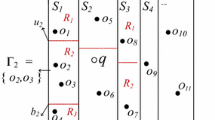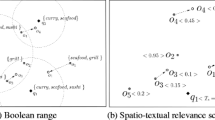Abstract
Existing works on moving objects mainly focus on a single environment such as free space and road network, and do not investigate the complete trip for humans who can pass several environments, e.g., road network, pavement areas, indoor. In this paper, we consider multiple environments and study moving objects with different transportation modes, also called generic moving objects. We aim to answer a new class of queries supporting three kinds of conditions: temporal, spatial, and transportation modes. To efficiently provide the result, we propose an index structure called TM-RTree, which takes into account the feature of moving objects in different environments and has the capability of managing objects on not only temporal and spatial data but also transportation modes. This property is not maintained by existing indices for moving objects. Different cases on transportation modes are supported. Correspondingly, several algorithms are developed. The TM-RTree and related algorithms are developed in a real DBMS to have a practical and solid result for applications. In the experiment, we conduct the performance evaluation using extensive datasets and compare the proposed technique with the other two competitors, demonstrating the efficiency and significant superiority of our solution in various settings.


















Similar content being viewed by others
Notes
we model the overall pedestrian area in a city as a large polygon with obstacles inside, denoting areas covered by buildings and roads for vehicles.
more queries see Appendix A
In the implementation, a movement tuple is developed to be a relational tuple containing three attributes (traj_id, box, m). In order to efficiently access the data in the future, we combine each movement tuple with its corresponding subtrip in one relational tuple. The sub trip is represented by a moving object.
References
http://www.census.gov/geo/www/tiger/tgrshp2010/tgrshp2010.html (2012)
Bauer V, Gamper J, Loperfido R, Profanter S, Putzer S, Timko I (2008) Computing isochrones in multi-modal, schedule-based transport networks. In: ACM GIS, Demo, p 78
Berchtold S, Böhm C, Kriegel HP (1998) Improving the query performance of high-dimensional index structures by bulk load operations. In: EDBT, pp 216–230
Bercken J, Seeger B, Widmayer P (1997) A generic approach to bulk loading multidimensional index structures. In: VLDB, pp 406–415
Booth J, Sistla P, Wolfson O, Cruz IF (2009) A data model for trip planning in multimodal transportation systems. In: EDBT, pp 994–1005
Cai Y, Ng R (2004) Indexing spatio-temporal trajectories with chebyshev polynomials. In: SIGMOD, pp 599–610
Chakka VP, Everspaugh A, Patel JM (2003) Indexing large trajectory data sets with seti. In: CIDR
Cong G, Jensen CS, Wu D (2009) Efficient retrieval of the top-k most relevant spatial web objects. PVLDB 2(1):337–348
Cong G, Lu H, Ooi BC, Zhang D, Zhang M (2012) Efficient spatial keyword search in trajectory databases. CoRR, abs/1205.2880
de Almeida VT, Güting RH (2005) Indexing the trajectories of moving objects in networks. GeoInformatica 9(1):33–60
Felipe ID, Hristidis V, Rishe N (2008) Keyword search on spatial databases. In: ICDE, pp 656–665
Forlizzi L, Güting RH, Nardelli E, Schneider M (2000) A data model and data structures for moving objects databases. In: SIGMOD, pp 319–330
Frentzos E (2003) Indexing objects moving on fixed networks. In: SSTD, pp 289–305
Gedik B, Liu L (2004) Mobieyes: distributed processing of continuously moving queries on moving objects in a mobile system. In: EDBT, pp 67–87
Güting RH, Almedia V, Ansorge D, Behr T, Ding Z, Höse T, Hoffmann F, Spiekermann M (2005) Secondo:an extensible dbms platform for research prototyping and teaching. In: ICDE, Demo Paper, pp 1115–1116
Güting RH, de Almeida VT, Ding ZM (2006) Modeling and querying moving objects in networks. VLDB J 15(2):165–190
Güting RH, Böhlen MH, Erwig M, Jensen CS, Lorentzos NA, Schneider M, Vazirgiannis M (2000) A foundation for representing and querying moving objects. ACM TODS 25(1):1–42
Hage C, Jensen CS, Pedersen TB, Speicys L, Timko I (2003) Integrated data management for mobile services in the real world. In: VLDB, pp 1019–1030
Jensen CS, Lu H, Yang B (2009) Graph model based indoor tracking. In: MDM, pp 122–131
Jensen CS, Lu H, Yang B (2009) Indexing the trajectories of moving objects in symbolic indoor space. In: SSTD, pp 208–227
Kollios G, Papadopoulos D, Gunopulos D, Tsotras VJ (2005) Indexing mobile objects using dual transformations. VLDB J 14(2):238–256
Dinh L, Aref WG, Mokbel MF (2010) Spatio-temporal access methods: Part 2 (2003–2010). IEEE Data Eng Bull 33(2):46–55
Li M, Dai J, Sahu S, Naphade MR (2011) Trip analyzer through smartphone apps. In: GIS, pp 537–540
Lu H, Cao X, Jensen CS (2012) A foundation for efficient indoor distance-aware query processing. In: ICDE, pp 438–449
Mokbel MF, Xiong X, Aref WG (2004) Sina: scalable incremental processing of continuous queries in spatio-temporal databases. In: SIGMOD Conference, pp 623–634
Pelanis M, Saltenis S, Jensen CS (2006) Indexing the past, present, and anticipated future positions of moving objects. ACM TODS 31(1):255–298
Pfoser D, Jensen CS (2003) Indexing of network constrained moving objects. In: GIS, pp 25–32
Pfoser D, Jensen CS (2000) Novel approaches in query processing for moving object trajectories. In: VLDB, pp 395–406
Popa IS, Zeitouni K, Oria V, Barth D, Vial S (2011) Indexing in-network trajectory flows. VLDB J 20(5):643–669
Reddy S, Mun M, Burke J, Estrin D, Hansen MH, Srivastava MB (2010) Using mobile phones to determine transportation modes. TOSN 6(2)
Sistla P, Wolfson O, Chamberlain S, Dao S (1997) Modeling and querying moving objects. In: ICDE, pp. 422–432
Stenneth L, Wolfson O, Yu P, Xu B (2011) Transportation Mode Detection using Mobile Devices and GIS Information. In: ACM SIGSPATIAL, pp 54–63
Tao Y, Papadias D (2001) Mv3r-tree: A spatio-temporal access method for timestamp and interval queries. In: VLDB, pp 431–440
Tao Y, Papadias D, Sun J (2003) The TPR*-Tree: an optimized spatio-temporal access method for predictive queries. In: VLDB, pp 790–801
Theodoridis Y, Vazirgiannis M, Sellis TK (1996) Spatio-temporal indexing for large multimedia applications. In: ICMCS, pp 441–448
Wang H, Zimmermann R (2011) Processing of continuous location-based range queries on moving objects in road networks. IEEE Trans Knowl Data Eng 23(7):1065–1078
Wang L, Zheng Y, Xie X, Ma WY (2008) A flexible spatio-temporal indexing scheme for large-scale gps track retrieval. In: MDM, pp 1–8
Wu D, Yiu ML, Cong G, Jensen CS (2012) Joint top-k spatial keyword query processing. IEEE Trans Knowl Data Eng 24(10):1889–1903
Xu J, Güting RH (2012) MWGen: a mini world generator. In: MDM, pp 258–267
Xu J, Güting RH (2013) A generic data model for moving objects. GeoInformatica 17(1):125–172
Yang B, Lu H, Jensen CS (2009) Scalable continuous range monitoring of moving objects in symbolic indoor space. In: CIKM, pp 671–680
Zhang D, Chee YM, Mondal A, Tung AKH, Kitsuregawa M (2009) Keyword search in spatial databases: Towards searching by document. In: ICDE, pp 688–699
Zheng Y, Chen Y, Xie X, Ma WY (2010) Understanding transportation mode based on GPS data for Web application, vol 4
Zheng Y, Xie X, Ma WY (2010) GeoLife: A collaborative social networking service among user, location and trajectory. Invited paper. IEEE Data Eng Bull 32(2):32–40
Zheng Y, Zhang L, Ma Z, Xie X, Ma WY (2011) Recommending friends and locations based on individual location history. TWEB 5(1):5
Zheng Y, Zhou X (2011) Computing with spatial trajectories, Springer
Acknowledgments
This work is supported in part by NSFC under grants 61300052, the Fundamental Research Funds for the Central Universities under grants NZ2013306 and Natural Science Foundation of Jiangsu Province of China under grants BK20130810.
Author information
Authors and Affiliations
Corresponding author
Additional information
Most of the work is done when the author is a Ph.D student in FernUniversität in Hagen, Germany.
Appendices
Appendix: – A Range Query Examples
-
Who passed the room No. 123 in the university on Tuesday afternoon?
-
Q.t: Tuesday afternoon
-
Q.s: room No. 123 in the university
-
Q.m: Indoor
-
-
Find all taxis passing through Alexender street on Saturday.
-
Q.t: Saturday
-
Q.s: Alexender street
-
Q.m: Taxi
-
-
Find out all people walking through zone A and moving around in a shopping mall on Saturday between 10am and 3pm.
-
Q.t: [10am, 3pm] on Saturday
-
Q.s: a region + a building
-
Q.m: {W a l k, I n d o o r}
-
-
Find all people who pass room No. 34 at the office building between 9:00am and 12:00am on Monday, and then take a bus to the train station.
-
Q.t: [9am, 12am] on Monday
-
Q.s: a region covering the building and the station
-
Q.m: < Indoor, Walk, Bus, Walk, Train >
-
-
Find all people who drive through the area A and then walk to the building X on Monday between [8am, 9am].
-
Q.t: [8am, 9am] on Monday
-
Q.s: a region including A and X
-
Q.m: < Car, Walk, Indoor >
-
Appendix: – B Experimental Statistics
Tables 6, 7, 8, 9, 10, 11, and 12
Rights and permissions
About this article
Cite this article
Xu, J., Güting, R.H. & Zheng, Y. The TM-RTree: an index on generic moving objects for range queries. Geoinformatica 19, 487–524 (2015). https://doi.org/10.1007/s10707-014-0218-2
Received:
Revised:
Accepted:
Published:
Issue Date:
DOI: https://doi.org/10.1007/s10707-014-0218-2




